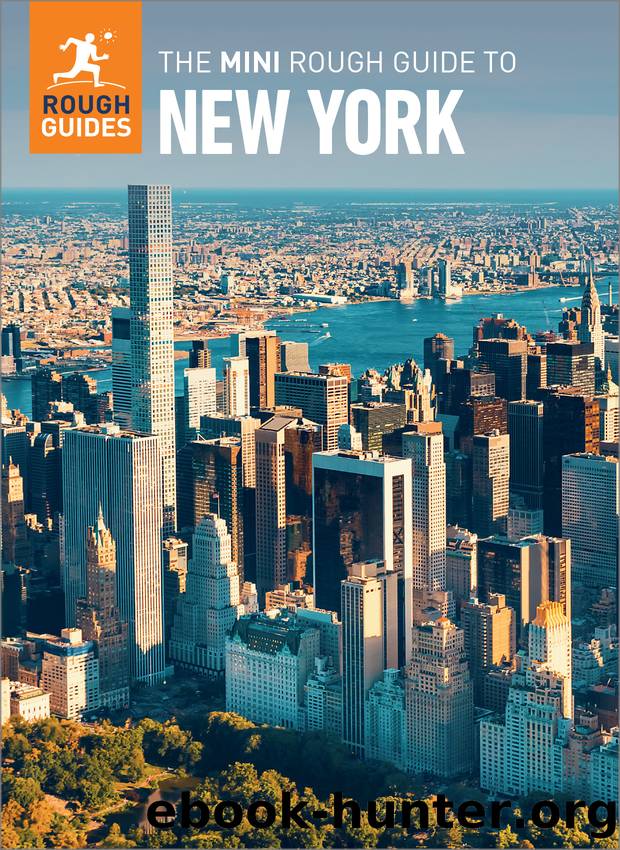The Mini Rough Guide to New York (Travel Guide eBook) by Rough Guides

Author:Rough Guides
Language: eng
Format: epub
Tags: Travel, NEW YORK
Publisher: Apa Publications
Published: 2022-07-14T04:57:54+00:00
Abe Nowitz/Apa Publications
The Gay Liberation statue in Christopher Park
Meatpacking District and Chelsea
The northwest corner of Greenwich Village from West 14th Street to Gansevoort Street is a designated historic district of cobbled streets and warehouses. Home to a meat market during the last century, the area is now awash with trendy boutiques, restaurants, bars, clubs and hotels.
The High Line ⢠[map] (www.thehighline.org; daily JuneâSept 7amâ11pm, AprâMay and OctâNov until 10pm, DecâMar until 7pm) is a major public park built on elevated railroad tracks. These tracks were originally constructed in the 1930s to lift freight trains off the streets of Manhattan. They have been converted into a beautifully landscaped walkway that stretches 1.45 miles (2.3km) from Gansevoort Street to West 34th Street and 10th Avenue, with multiple entrances and exits. The High Line ends at the Hudson Yards development of skyscrapers, where the Edge (www.edgenyc.com/en) offers sensational panoramic views 100 stories up.
Housed in a striking building by architect Renzo Piano back in the Meatpacking District, the excellent Whitney Museum of American Art # [map] (www.whitney.org; Mon and WedâThu 10.30amâ6pm, Fri 10.30amâ10pm, Sat and Sun 11amâ6pm) was originally founded by Gertrude Vanderbilt Whitney, an artist from one of New Yorkâs wealthiest families. It is one of the few museums that is dedicated solely to American art and that seeks out works from alternative media, such as film and video. By focusing its collection on contemporary American artists (both those of Ms. Whitneyâs era and those of today), it has gone a long way toward changing attitudes about the diversity and strength of the countryâs art. The permanent collection includes works by such artists as Andy Warhol, Alexander Calder, Georgia OâKeefe, Jackson Pollock, Jasper Johns, and Mark Rothko. Curators continue to build and show works by living artists.
Village voices
Since the Art Nouveau period, Greenwich Village has been one big âvillage of geniusâ and home of the artistic avant-garde. The radical paper Masses, whose contributors included Maxim Gorki, Bertrand Russell, and John Reed, had its offices here. In 1914, Gertrude Vanderbilt Whitney opened a gallery and provided a platform for contemporary artists, much of whose work was highly controversial. In 1916, members of the Playwrightsâ Theater settled on MacDougal Street and soon achieved fame, Eugene OâNeill among them.
After World War II the Bohemian image of âthe Villageâ persisted. In the 1950s, the beatnik movement flowered (Jack Kerouac and Allen Ginsberg); in the 1960s and early â70s the area was home to hippies and anti-Vietnam war activists (Abbie Hoffman and Jerry Rubin).
Download
This site does not store any files on its server. We only index and link to content provided by other sites. Please contact the content providers to delete copyright contents if any and email us, we'll remove relevant links or contents immediately.
Giovanni's Room by James Baldwin(7117)
The Plant Paradox by Dr. Steven R. Gundry M.D(2512)
The Stranger in the Woods by Michael Finkel(2371)
Miami by Joan Didion(2192)
Wild: From Lost to Found on the Pacific Crest Trail by Cheryl Strayed(2178)
INTO THE WILD by Jon Krakauer(2134)
Trail Magic by Trevelyan Quest Edwards & Hazel Edwards(2106)
DK Eyewitness Top 10 Travel Guides Orlando by DK(2081)
The Twilight Saga Collection by Stephenie Meyer(2060)
Vacationland by John Hodgman(2056)
Nomadland by Jessica Bruder(1988)
Birds of the Pacific Northwest by Shewey John; Blount Tim;(1902)
The Last Flight by Julie Clark(1880)
Portland: Including the Coast, Mounts Hood and St. Helens, and the Santiam River by Paul Gerald(1838)
On Trails by Robert Moor(1823)
Deep South by Paul Theroux(1750)
Blue Highways by William Least Heat-Moon(1696)
Trees and Shrubs of the Pacific Northwest by Mark Turner(1663)
1,000 Places to See in the United States and Canada Before You Die (1,000 Places to See in the United States & Canada Before You) by Patricia Schultz(1585)
